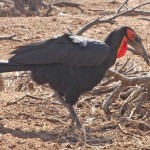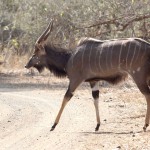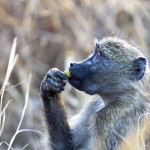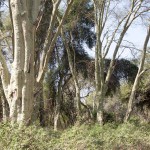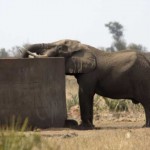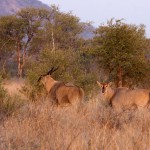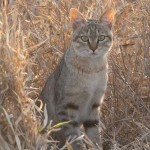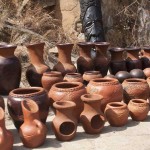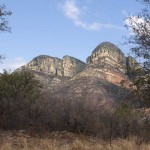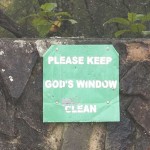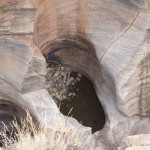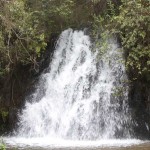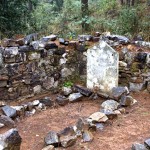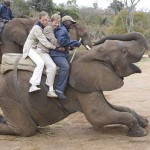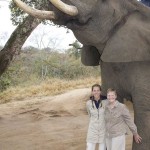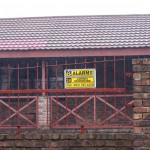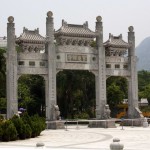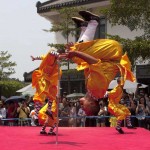Our wonderful two-week stay in the Park was rapidly coming to an end. The last Rest Camp was Punda Maria and we pitched our tent right beside a hide that built over the fence. While we were in the main building registering, word came that there were lion cubs by the hide. We couldn’t get there fast enough to see them, but I determined to keep a flashlight close while I slept and if I heard any strange noises at all I would sneak into the hide. I did get up once, but didn’t see anything.
The next day’s drive was one of the most pleasant of the whole Safari. We found our way to Nyala Loop – the only location in which there is a population of the rare Nyala antelope. The bucks were graceful and had beautiful markings; a delight to watch in the Fever Tree Forest. (These trees have bark like Aspen, but instead of white, it is a pale yellowish-green. We mused as to how folks with “the fever” might look and if that’s how the trees got their name.) The Pafuri Picnic Spot was
delightful, with a well-watered river flowing nearby. It was here that we saw seven different kinds of animals all coming for water at the same time: elephants, baboons, Nyala, zebras, Impala, crocodiles and wart hogs. There was a whole tribe of baboons; the young ones played tirelessly while the older ones sat at the water’s edge in quiet companionship watching the river. It was in this area that we saw a pair of Southern Ground Hornbills – a bird almost as big as a turkey and quite rare; in fact, on the endangered species list. Another place to get out of the car was at Crooke’s Corner; so-called because South Africa, Mozambique and Zimbabwe join borders there and in the old days it was used as a convenient place for criminals to escape. The shores of the river were lined with crocodiles and hippos (can’t help but wonder how the escapees fared with them!). Others there marveled that we hadn’t had to run the elephant gauntlet. Earlier there had been a herd of elephants that simply would not leave the road. One by one cars would look for a little opening and then dash through. This peeved a couple of the bulls so much that they sometimes chased the car down the road for a few feet.
We had already had our almost-encounters with elephants and were glad not to have another one. Our little car could have been crushed with one foot or sent rolling with a flip of the trunk. One of our incidents was when we decided we really had to leave a peaceful Hide and get back to camp before they closed the gate; I would not have wanted to pay the stiff fine that was levied on tardy arrivals. We started towards the camp and figured we had ten minutes to spare. Then “they” came! The giants strode leisurely down the road, in no hurry to actually cross it. The shrubs beside the road made good browsing and they had the right-of-way. There we sat, casting nervous glances at our watches and trying to inch closer without causing any consternation on their part.
The words of the lady who had made all the reservations for us came to mind: “you cannot be late into the camp site; even if you were stopped by an elephant herd in the middle of the road and have pictures to prove it – that excuse isn’t good enough!” Those words seemed pretty innocuous on paper, but now that was exactly our predicament here in real life.
Lydia tried moving forward ever so slowly when it seemed a gap in the line-up was about to appear. That didn’t go well. One young bull, decided to put us in our place; trumpeting loudly, he threw his trunk skyward and made a false charge. We took the hint and moved away. After several more stressful minutes a little hole did appear and we rushed through it. A couple of the big guys looked after us in disgust, but made no move to follow.
The other incident took place at a reservoir. We happened upon it while every elephant within a ten-mile radius was there. There must have been a 100 of them – the big ones drinking from the reservoir, the young ones from the concrete trough. Some teenagers were jostling and it was delightful viewing. Slowly the group started to break up; a half-dozen at a time walked across the road in front of us and began browsing in the nearby areas. It seemed we were of no concern to them whatever so we continued taking pictures and feasting our eyes. It was then we noticed that a very large bull had come around the trees on the other side and suddenly we felt hemmed in. It was not a good feeling. Time to retreat. The big guy started to follow us down the road, but stopped after a few feet. We continued our viewing from a much safer distance.
The next day we were to leave the Park and make our way to the Blyde Canyon Forever Resort. Our friends asked to see the directions that had been written out for us and all agreed we shouldn’t follow them. “That’s a very bad area for two women to drive through” they said, “and besides, by going this way (pointing to the map) you can stay in the Park for another four hours!” It made sense to us and we took their good advice. By making the drive they recommended, we saw two animals we hadn’t seen before: the largest antelope, the Eland which is quite rare, and a wild cat. This little guy was hunting birds in the tall grass and was very picturesque in the morning sun. He was the size of our house cats and had exactly the same mannerisms. It was a joy to see him there doing his thing. It amazed me that some of the smallest animals could survive in that rugged environment living such solitary
lives.
A sense of sadness enveloped us as we left the Park. Every day had been an adventure; one that I didn’t want to come to an end. All the people we visited with said “you’ll be back; the Park draws you and you can’t stay away.” I believe it, but at this point, I have no
idea if I will ever be able to return. Remember, it took me 20 years to get enough frequent flyer miles for the trip!
As we drove towards Blyde Canyon, the scenery began to change. It was quite a bit greener and occasionally we passed big truck farms. The cabbage and other produce looked lush and inviting in neat well-cared-for rows. Fruit trees were loaded with oranges and native vendors set up shop anywhere and everywhere. I snapped a few pictures of farms, horses and cows to show to my father, knowing he would be more interested in that than in the myriads of wildlife we had been so fortunate to see.
The drive up into the Drakensberg Mountains was beautiful. When finally we arrived at Blyde Canyon, checked in and found a camping spot, the loss of the Park really engulfed us. It was cold and rainy; there was no communal kitchen (just a wash-up area) – cooking had to be done over a grill; and the place certainly wasn’t alive with happy folks full of enthusiasm for what they had seen that day. After the tent was set up, Lydia said “I don’t really want to stand out in the rain and barbeque.” So we splurged and went to the restaurant. We stayed a long time, mostly waiting for bedtime so we wouldn’t have to try and think of something to do in that cold weather. We were glad to be on our way the next morning.
We made stops at the places recommended: the Blyde Canyon Dam, Lowveld and the Three Rondawels, Bourke’s Luck Potholes and God’s Window. The scenery had great potential, but rain and fog kept us from seeing it. It was dry at Bourke’s Luck Potholes and we were able to explore the area, but were accompanied by a couple hundred school children who had been bused in and were noisily enjoying themselves. No visibility at God’s Window whatsoever. We asked a lady just returning from the walk if she had seen anything and she shouted “no!” as she wrapped her raingear closer. We didn’t even get out of the car but were content with taking a picture of their sign which read “Keep God’s Window Clean!” Continuing towards Hazyview we did enjoy Bougainville in full bloom and the acres and acres of oranges and bananas. We attempted to find every waterfall listed as we drove along, but for the most part they were disappointing because of the weather.
There was, however, a bit of an adventure at Maria Shires Falls. The sign was small, unlike the others which had been clearly marked. We turned on the doubtful-looking road and began climbing. It was what I considered a not often-used logging road. It was narrow, rough and a bit slippery from the rain. A couple times passage looked doubtful but we forged ahead. Finally coming to a “T” I suggested we take the downhill side. Shortly after we found another well-worn sign for the falls. They were nowhere in sight, but we could hear them. Having invested some time and anxiety into this stop already, we were not willing to abandon it, so we went exploring. Down a steep, muddy, brush-covered incline we finally found the waterfall. It was pleasant, but nothing spectacular. Where we had parked there was a small burial plot with the headstone of Maria Shires and family. Upon leaving the area, I again suggested we turn towards the downhill side and within a mile we came out on a much better road which led to the main highway. We had completely missed this road going in because the sign was actually beyond it.
At Hazyview we had no trouble finding “Elephant Whispers.” It is an elephant sanctuary that was recommended by friends in the Park because I said I had promised the grandchildren that I would go for an elephant ride. The first hour was spent in elephant education complete with one of the big guys there, following orders (well, mostly) and us getting the hands-on experience of feeding him, touching him and having our picture taken with him. Very informative. Then came the ride. They chose a small one, only eleven years old to be our steed. A native “groomer” was already aboard. On command the elephant knelt and we were boosted up and told to hang on tight to the groomer. He was a pleasant young man who had to drop out of agricultural college for lack of funds. The trainer and owner walked beside the riders using their own cameras to take pictures. It was a fun time.
That night we drove into Johannesburg and spent an hour trying to find our lodging. It was dark, we couldn’t read street signs (mostly because we had trouble even finding them), and the map didn’t seem to be of any help. We stopped and asked at a gas station, but nobody knew for sure and their “guesses” were given with such a heavy accent that we left them none the wiser. As we were turning around in the parking lot of a restaurant we saw an older couple coming to their car. “I want to talk to them” I exclaimed, adding “I’ll surely be able to understand them.” Everyone spoke English, but the black South Africans mixed that liberally with Afrikaans, spoke very quickly, and had very heavy accents; my aging ears couldn’t handle that.
Sure enough this nice couple said “that’s close to where we live, follow us” – and we did. When we got in the area he wasn’t sure so he called the owner of the Mbizi Backpackers and it so happened that he was at that moment driving by us, having been to the airport to pick up other guests. So we thanked our rescuers profusely and hurried after the proprietor. The lodging was a regular house with nice back and front yards and a kitchen for the guests to do their own cooking. One thing we had noticed on our drive was that all houses were behind wrought-iron fences with huge locking gates. Some fences were electrified and all had signs giving the name of their security company who claimed they had “immediate armed response.” Missionaries had told us that thievery is rampant and that we would have to be very careful everywhere except in the Park. The yard had a fence around it, the gate had two locks, the entrance to the porch had a lock, the front door on the house had two locks, and all the windows were covered with wrought-iron grates. It was a bit depressing after the wonderful feeling of freedom and lack of distrust in the Park.
We spent the next day shopping and the following morning left for the airport. After the long flight back to Hong Kong we were faced with another 12-hour layover in China, but much more pleasant. We were prepared mentally and physically (yes, I had my sandals on my feet and the packet of bandaids in my pocket) and though it was as hot as before it didn’t seem like it because with took an hour-long tram ride, called the 360 Degree Skyrail, up a mountain to the ancient Ngong Ping fishing village. The largest seated, outdoor Buddha watched over the village and monks sat by shops waiting for donations. A troupe of “warriors” had quite a show right at noon showing off their agility and skills with the traditional weapons. At the bottom of the mountain I guarded our stuff while Lydia did some exploring of a very modern mall filled with happy shoppers.
Getting through customs proved a bit traumatic: I had forgotten to take my Leatherman out of the camera bag so it was thrown away. Likewise all the jerky we had bought for treats (in spite of the fact that the store keeper had insisted that we could take it in the U.S.); Lydia had temporarily misplaced her boarding ticket and was delayed. We also forgot to take one of the pieces of luggage out of the trunk of the car so that was another trip to the car rental area. I tried to exchange money back to US dollars and they wouldn’t do it until I could show them a boarding pass, so back and forth and forth and back we went. Finally we were safely on the airplane and 13 hours later landed in San Francisco at midnight, ready to face a four-hour drive to Lydia’s apartment in Redding.
If you’re thinking about such a trip, I highly recommend contacting the folks at African Safari Journals. Wilma was full of excellent suggestions, could answer any question I threw at her and she made all the Park Reservations for us. The final print-out of our itinerary was chuck-full of useful information and suggestions for things to do and see while at each camp. Bruce shared his ebook “How to Take Better Safari Pictures” which was quite helpful. These folks live in the area and go into the Park several times each year; their passion for Kruger National Park is unparalleled and their encouragement for us to do the “self-catered, self-guided” tour was the best advice given to us. Thank you, African Safari Journals! (A link to their website is on my home page.)

